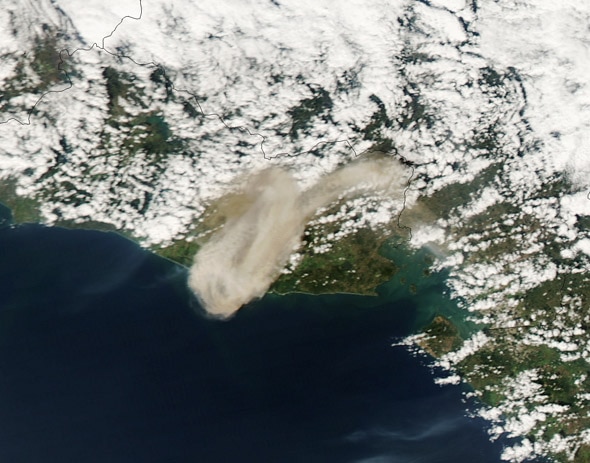Create a free profile to get unlimited access to exclusive videos, sweepstakes, and more!
Salvadoran Volcano Ends 2013 With a Blast

The west coast of Central America is lined with volcanoes. Some of them are quiescent, some active. One of them, San Miguel (also known as Chaparrastique) in El Salvador, has erupted in modern times, as recently as 2002.
On Dec. 29, 2013, it underwent a decent-sized paroxysm, blasting a cloud of ash, steam, and gas that rapidly expanded to about 40 kilometers in width, blowing east and north for more than a hundred kilometers.
This area is a subduction zone, where one continental plate is sliding under another. Stress builds up in the rocky plates, which can slip suddenly and cause earthquakes. Magma from deep inside the Earth can make its way to the surface as well, so subduction zones are frequently dotted with volcanoes. On Mar. 31, 2010, astronauts on the International Space Station took this photo of the San Miguel area, which more clearly shows whatâs what:
As you can see, San Miguel (on the right) is taller than the others; itâs 2,130 meters high (nearly 7,000 feet). All four in the picture are stratovolcanoes, the classic cone-shaped mountains built up as thick lava and ash erupt from a vent.
Volcanoes are fascinating for a lot of reasons, but to me one of their special draws is the irony implicit in them. They can cast destruction on a vast scale, but also build up land and provide fertile soil around them for farming (especially grapes and coffee). They are caused by tectonic activity, which again can be a hugely violent and catastrophic force, but is also perhaps necessary for life as we know it on Earth.
The mantle under the Earthâs solid crust convects and churns, pushing and pulling on the Earthâs crust, causing all that tectonic motion.* That in turn is due to the heat both trapped and generated by the Earthâs core. That same core is responsible for creating the Earthâs magnetic field, which protects us from solar stormsâthis may be why the Earth still has an atmosphere after billions of years. The solar wind can erode away the air, blowing it out into space. We think thatâs why Mars has such a thin atmosphere; its lack of a strong global magnetic field has left it prey to that erosion.
And back on the surface, tectonics builds up mountains, tears vast rifts, buries older land and creates it anew. Push, pull, up, down, destruction, creation ⦠and here we are, on the last day of the year, the first day of 2014 poised to start. Cycles are the nature of life, and our celebration of them is warranted ⦠as long as we appreciate them, and learn from them, and use them to better understand our world.
Correction, Dec. 31, 2013: I originally wrote that magma convects under the surface, causing tectonics. It's actually the mantle, the plastic-like material under the surface, that is convecting. The heat from the mantle is what creates magma.














